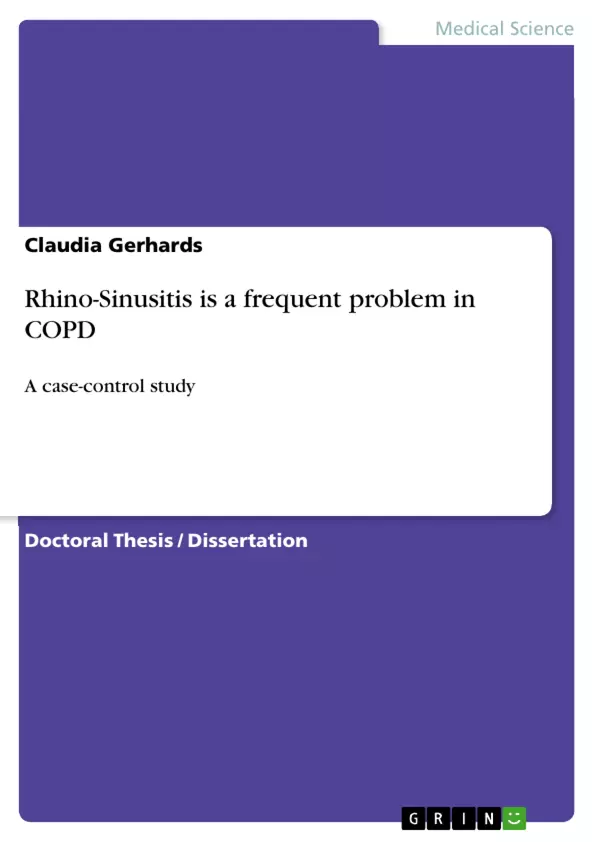Background: The prevalence and nature of upper respiratory changes in patients with COPD and its impact on COPD outcomes are unclear.
Methods: Patients with stable COPD GOLD stages 1-4 and a control group without COPD matched in gender and age were recruited at the University Hospital Basel. The difference in the Sino-Nasal-Outcome-20 questionnaire (SNOT-20) score was compared between the COPD cohort and the control group. Secondary outcomes were sub-scores SNOT-Primary Nasal Symptoms (SNOT-PNS), SNOT-Secondary Nasal Symptoms (SNOT-SNS) and SNOT-Quality of Life (SNOT-QOL). Abnormal findings were defined as a value of >12 points and absolute values were compared.
Furthermore the Rhino-conjunctivitis Quality of Life questionnaire (RQLQ) and three visual analogue scales (VAS) estimating the amount of nasal secretions, bilateral perception of nasal congestion and nasal itching, were applied. As objective clinical surrogate markers for nasal inflammation, computer tomography (CT) scans of the para-nasal sinuses were performed and assessed with the Newman and the Lund-Mackay scoring system.
Results: Data from 83 COPD patients (35 females, mean age: 67 years ± 10) and 34 controls (18 females, mean age: 67 years ± 12) were analysed. Forty-eight COPD patients (59%) and 14 controls (41%) had an abnormal SNOT-20 score
(p=0.088). An abnormal SNOT-PNS score was found in 49 COPD patients (59%) and in 9 controls (26%) (p<0.01). SNOT-PNS, SNOT-SNS, RQLQ and nasal symptoms (VAS) showed significantly higher values in the COPD group compared to the control group (all p<0.01). Forty-eight COPD patients (59%) and 12 control patients (35%) had an abnormal Lund-Mackay score (p=0.02). The COPD group had a significantly higher median CT Lund-Mackay (p=0.03).
Also, forty-eight COPD patients (58%) showed a pathological CT Newman score, whereas 12 controls (35%) had an abnormal CT Newman score (p=0.03). The COPD group had a significantly higher median CT Newman score with 2.0 (ICR 4) than the control group with 0.0 (ICR 1) (p=0.03). Nasal symptom and CT scores did not correlate with each other.
Conclusion: Evidence for a higher prevalence of subjective and radiographic signs of rhino-sinusitis in COPD patients compared to controls without COPD was found. Current smoking was highly associated with findings in SNOT-PNS scores (p<0.01) and abnormal CT Newman scores (p=0.046), but did not show significantly more abnormal SNOT-20 scores (p=0.11).
Table of Contents
- Summary
- Background
- Outline of the Chronic Obstructive Pulmonary Disease (COPD)
- Vicious Circle Hypothesis in the Pathogenesis and Pathophysiology of COPD
- COPD GOLD Staging
- Combined COPD Risk Assessment
- Research Questions of the Present Dissertation
- Outline of Chronic Rhino-Sinusitis (CRS)
- Materials and Methods
- Subjects
- Ethical Consideration, Data Protection, and Patient Information
- Study design
- Examination Tools
- Data Analysis
- Results
- Study Flow Charts
- Demographical Characteristics and Clinical Features of the Patients
- Patients’ reports of upper airway symptoms were more frequent in the COPD cohort but they were not associated with a poorer quality of life
- Lund-MacKay Staging System
- Correlation between Subjective and Objective Parameters of upper airway involvement
- Impact of cigarette smoking on upper airway involvement
- Discussion
- Limitations
- Conclusion
Objectives and Key Themes
The aim of the present study was to investigate the prevalence of chronic rhinosinusitis in patients with COPD and to compare them with individuals without COPD regarding subjective and objective signs. The study was embedded in a larger clinical study that aimed to investigate individuals with COPD and determine the role of upper respiratory symptoms and chronic rhinosinusitis in the development of COPD. The specific research question of the present dissertation was to identify the prevalence of chronic rhinosinusitis in individuals with stable COPD compared to individuals without COPD.
- The prevalence of chronic rhinosinusitis in patients with COPD compared to a healthy control group.
- The relationship between subjective and objective signs of rhinosinusitis in the COPD cohort.
- The impact of cigarette smoking on upper airway involvement and its association with chronic rhinosinusitis in individuals with COPD.
- The impact of rhinosinusitis on the quality of life in individuals with COPD.
- The implications of the findings for a better understanding of the "united airway disease" concept.
Chapter Summaries
- Background: This chapter provides a comprehensive overview of chronic obstructive pulmonary disease (COPD), outlining its definition, burden, risk factors, and pathophysiology. The vicious circle hypothesis is explained, highlighting the role of bacterial colonization in the progression of COPD. The chapter concludes with a detailed discussion of chronic rhinosinusitis (CRS), including its definition, epidemiology, and the role of allergy in its development.
- Materials and Methods: This chapter details the study design, participant recruitment, and data collection procedures. It outlines the specific examination tools used to assess COPD severity, rhinosinusitis symptoms, and other relevant parameters. The chapter concludes with a description of the statistical analysis methods used to analyze the collected data.
- Results: This chapter presents the findings of the study, focusing on the prevalence of subjective and objective signs of rhinosinusitis in the COPD cohort compared to controls. It examines the association between subjective and objective parameters, the impact of cigarette smoking, and the influence of rhinosinusitis on the quality of life in individuals with COPD.
- Discussion: This chapter interprets the findings, comparing them with existing literature and discussing the implications of the results for the understanding of COPD and rhinosinusitis. It explores the concept of a "united airway disease" and examines the limitations of the study.
Keywords
The key terms and concepts explored in this dissertation include chronic obstructive pulmonary disease (COPD), chronic rhinosinusitis (CRS), upper respiratory tract involvement, subjective and objective assessment, cigarette smoking, quality of life, and the "united airway disease" concept. This dissertation utilizes both clinical and radiological data to investigate the prevalence of CRS in individuals with stable COPD, examining its impact on symptom burden, quality of life, and disease severity.
- Quote paper
- Dr. med. Claudia Gerhards (Author), 2015, Rhino-Sinusitis is a frequent problem in COPD, Munich, GRIN Verlag, https://www.grin.com/document/310996



